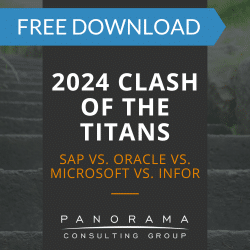Although both organizational change management and innovative communication tools have been around for some time, many organizations don’t combine them. As a change agent, you can pick and choose which tools work best for you, and you can adjust them to suit the needs of your ERP implementation.
First, let’s lay down some ground rules for what makes an effective communication tool for change management:
- The tool must help the people involved understand the change.
- The tool must minimize disruption without dismissing concerns.
- The tool must instill accountability and delivery clarity.
- The tool should be able to boost employee morale and drive involvement.
- The tool should captivate your audience and promote buy-in.
Ultimately, communications tools should help tackle common challenges of implementing new ERP software, such as resistance to change. Following are ten traditional and modern tools you can add to your change toolkit:
Traditional Communication Tools
Traditional communication formats cultivate trust with most employees as something is comforting about interacting on a non-digital level.
In fact, if you’re in the early stages of business transformation, traditional communication tools might be most effective tools you have.
The Beginner’s Guide to Digital Transformation
What are the 6 secrets to digital transformation that are helping organizations build competitive advantage?
1. Bulletin Board
Put up a bulletin board where employees can post questions. Make it clear that questions will receive answers, and statements will be read and recorded.
Some companies issue different colored index cards or pins to identify which department a question comes from. This helps you provide more relevant answers.
2. Town Hall Meetings
Failing to communicate the project vision is one of the common struggles in an ERP project or business transformation. Hosting town hall meetings allows you to effectively communicate with employees at all levels of the organization.
During these meetings, clearly explain the project vision in a compelling manner. Several times throughout the meeting, open the floor to questions. If you make people wait until the end, you’ll lose them.
If employees express frustration during the meeting, offer to meet with these individuals face-to-face. This may come as a surprise to some employees – according to Forbes, less than a third of employees believe that there will be any changes based on their input.
When our clients conduct town hall meetings, they typically find that these meetings increase alignment among executives, the ERP project team and the change management team.
3. Playbooks
Playbooks help coaches guide their teams to victory, and they can help you too. Essentially, you’re telling your employees what changes are coming and how they can prepare.
The playbook should be high-level and easy to skim. It should include:
- The project’s one-sentence goal
- The vision statement
- A list of the people and systems directly impacted
- A list of the people and systems indirectly impacted
- A list of new technology being implemented
4. One-on-one Meetings
When our consultants work with change agents, we help them develop elevator pitches appropriate for each stakeholder group. The elevator pitch can be used in one-on-one meetings to explain why the change is happening and what specifically is changing.
These meetings should occur at key milestones throughout the project. They should be two-way conversations that encourage employees to share feedback.
In our experience, one-on-one meetings can be more emotional than team meetings, so we typically help change agents develop key messaging to address various emotional responses.
Mobile Communication Tools
While you may have security concerns about mobile apps for the workplace, these apps are specifically designed with security in mind. Here a few you should consider if you want to improve your change communication:
5. Slack
Slack is well-known for its desktop software that works as a team communication hub. In Slack, you can create different boards for anything and everything.
You can tag people in conversations, nudge them and mark certain statements with a tag making them easy to find later. The nudge and tagging features can make a big difference when it comes to addressing key issues with employees.
Troop allows individual communication and can store the entire history of a conversation.
This app also allows you to set administrators or moderators for group chats, so you can allow teams to discuss the project but have their manager moderate the discussion.
Software Communication Tools
Innovative software usually doesn’t have too much pushback when you try to integrate it into your change program. Most of these tools are reasonably priced and require no training.
7. Calendly
It’s more of a service than a software solution, and the only person that has to do anything is you. Create an account, and then use your unique code to direct people to your calendar. If someone wants to schedule a meeting with you, they must select from one of your open time slots.
8. Gensuite
A software solution specifically for change management teams, Gensuite focuses on the impact of change. Teams can use Gensuite to plan and manage risk while working towards legal compliance.
The system is flexible and allows stakeholders to engage in different steps of the change plan. You can customize controls, restrict certain users and automate communication.
9. Redbooth
Redbooth uses a task system to restrict and direct communication. The goal with Redbooth is to restrict communication to that which is relevant to the task or project. Employees must sort, organize and tag moveable tasks to keep communication concise and avoid repetitive questions.
10. Blogin
One of the biggest struggles that change agents face is helping employees work through deep-set feelings of uncertainty. A lot of this uncertainty comes from not having access to information.
Blogin acts as an internal company blog where you can archive company knowledge. It allows staff and team members to share information, search through the information, make suggestions for additions and ask questions.
Blogin keeps information flowing without disrupting the project. It’s a great place to put meeting minutes, your change management playbook and more.
Which Tools Will Work Best for You?
Change agents know that each project requires a different approach, which is why it’s critical to have more than just a few tools on hand. It’s also critical for change agents to understand change management. To learn more about it, refer to our blog, “What is Change Management?”
Panorama’s ERP consultants can help you build a change activation toolkit that incorporates some of the tools mentioned here and provides guidelines for developing messaging. We’ll help you proactively lead and inspire your employees to embrace change.














